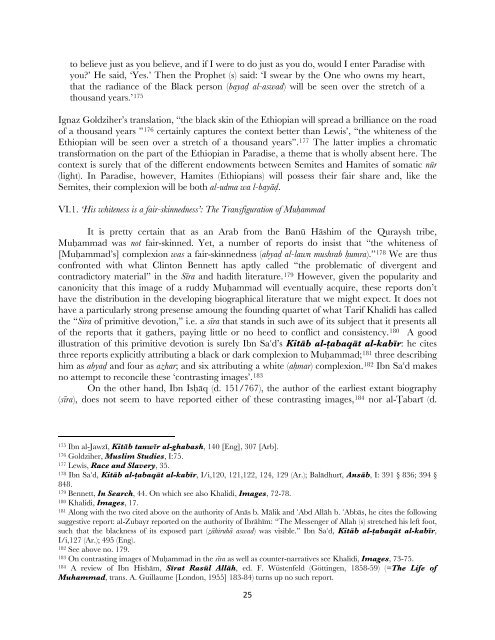“Anyone who says that the Prophet is black should be killed”: The ...
“Anyone who says that the Prophet is black should be killed”: The ...
“Anyone who says that the Prophet is black should be killed”: The ...
Create successful ePaper yourself
Turn your PDF publications into a flip-book with our unique Google optimized e-Paper software.
to <strong>be</strong>lieve just as you <strong>be</strong>lieve, and if I were to do just as you do, would I enter Parad<strong>is</strong>e with<br />
you?’ He said, ‘Yes.’ <strong>The</strong>n <strong>the</strong> <strong>Prophet</strong> (s) said: ‘I swear by <strong>the</strong> One <strong>who</strong> owns my heart,<br />
<strong>that</strong> <strong>the</strong> radiance of <strong>the</strong> Black person (baya∙ al-aswad) will <strong>be</strong> seen over <strong>the</strong> stretch of a<br />
thousand years.’ 175<br />
Ignaz Goldziher’s translation, “<strong>the</strong> <strong>black</strong> skin of <strong>the</strong> Ethiopian will spread a brilliance on <strong>the</strong> road<br />
of a thousand years ” 176 certainly captures <strong>the</strong> context <strong>be</strong>tter than Lew<strong>is</strong>’, “<strong>the</strong> whiteness of <strong>the</strong><br />
Ethiopian will <strong>be</strong> seen over a stretch of a thousand years”. 177 <strong>The</strong> latter implies a chromatic<br />
transformation on <strong>the</strong> part of <strong>the</strong> Ethiopian in Parad<strong>is</strong>e, a <strong>the</strong>me <strong>that</strong> <strong>is</strong> <strong>who</strong>lly absent here. <strong>The</strong><br />
context <strong>is</strong> surely <strong>that</strong> of <strong>the</strong> different endowments <strong>be</strong>tween Semites and Hamites of somatic når<br />
(light). In Parad<strong>is</strong>e, however, Hamites (Ethiopians) will possess <strong>the</strong>ir fair share and, like <strong>the</strong><br />
Semites, <strong>the</strong>ir complexion will <strong>be</strong> both al-udma wa l-bay§∙.<br />
VI.1. ‘H<strong>is</strong> whiteness <strong>is</strong> a fair-skinnedness’: <strong>The</strong> Transfiguration of MuÈammad<br />
It <strong>is</strong> pretty certain <strong>that</strong> as an Arab from <strong>the</strong> Banå H§shim of <strong>the</strong> Quraysh tri<strong>be</strong>,<br />
MuÈammad was not fair-skinned. Yet, a num<strong>be</strong>r of reports do ins<strong>is</strong>t <strong>that</strong> “<strong>the</strong> whiteness of<br />
[MuÈammad’s] complexion was a fair-skinnedness (abya∙ al-lawn mushrab Èumra).” 178 We are thus<br />
confronted with what Clinton Bennett has aptly called “<strong>the</strong> problematic of divergent and<br />
contradictory material” in <strong>the</strong> SÊra and hadith literature. 179 However, given <strong>the</strong> popularity and<br />
canonicity <strong>that</strong> th<strong>is</strong> image of a ruddy MuÈammad will eventually acquire, <strong>the</strong>se reports don’t<br />
have <strong>the</strong> d<strong>is</strong>tribution in <strong>the</strong> developing biographical literature <strong>that</strong> we might expect. It does not<br />
have a particularly strong presense amoung <strong>the</strong> founding quartet of what Tarif Khalidi has called<br />
<strong>the</strong> “Sira of primitive devotion,” i.e. a sÊra <strong>that</strong> stands in such awe of its subject <strong>that</strong> it presents all<br />
of <strong>the</strong> reports <strong>that</strong> it ga<strong>the</strong>rs, paying little or no heed to conflict and cons<strong>is</strong>tency. 180 A good<br />
illustration of th<strong>is</strong> primitive devotion <strong>is</strong> surely Ibn Sa#d’s Kit§b al-ãabaq§t al-kabÊr: he cites<br />
three reports explicitly attributing a <strong>black</strong> or dark complexion to MuÈammad; 181 three describing<br />
him as abya∙ and four as azhar; and six attributing a white (aÈmar) complexion. 182 Ibn Sa#d makes<br />
no attempt to reconcile <strong>the</strong>se ‘contrasting images’. 183<br />
On <strong>the</strong> o<strong>the</strong>r hand, Ibn Isȧq (d. 151/767), <strong>the</strong> author of <strong>the</strong> earliest extant biography<br />
(sÊra), does not seem to have reported ei<strong>the</strong>r of <strong>the</strong>se contrasting images, 184 nor al-•abarÊ (d.<br />
175 Ibn al-Jawzī, Kitāb tanwīr al-ghabash, 140 [Eng], 307 [Arb].<br />
176 Goldziher, Muslim Studies, I:75.<br />
177 Lew<strong>is</strong>, Race and Slavery, 35.<br />
178 Ibn Sa#d, Kit§b al-ãabaq§t al-kabÊr, I/i,120, 121,122, 124, 129 (Ar.); Bal§dhurÊ, Ans§b, I: 391 § 836; 394 §<br />
848.<br />
179 Bennett, In Search, 44. On which see also Khalidi, Images, 72-78.<br />
180 Khalidi, Images, 17.<br />
181 Along with <strong>the</strong> two cited above on <strong>the</strong> authority of An§s b. M§lik and #Abd All§h b. #Abb§s, he cites <strong>the</strong> following<br />
suggestive report: al-Zubayr reported on <strong>the</strong> authority of Ibr§hÊm: “<strong>The</strong> Messenger of Allah (s) stretched h<strong>is</strong> left foot,<br />
such <strong>that</strong> <strong>the</strong> <strong>black</strong>ness of its exposed part (í§hiruh§ aswad) was v<strong>is</strong>ible.” Ibn Sa#d, Kit§b al-ãabaq§t al-kabÊr,<br />
I/i,127 (Ar.); 495 (Eng).<br />
182 See above no. 179.<br />
183 On contrasting images of MuÈammad in <strong>the</strong> sÊra as well as counter-narratives see Khalidi, Images, 73-75.<br />
184 A review of Ibn H<strong>is</strong>h§m, SÊrat Rasål All§h, ed. F. Wüstenfeld (Göttingen, 1858-59) (=<strong>The</strong> Life of<br />
Muhammad, trans. A. Guillaume [London, 1955] 183-84) turns up no such report.<br />
25
















